Listening to music at home
Somehow it happened, but I never had a music center, a maximum of the Soviet tape recorder Mayak-223 and a couple of speakers. It was possible to join the digital sound and compact discs only with the advent of a PC-compatible computer in the early 2000s. Yes, and the CD-drive was expensive and did not appear immediately. However, at that time the MP3 revolution was developing, and accordingly, like many, I started to grow a small collection of music on a screw, something was copied from my friends, something riped off of my own CDs, so as not to pull constantly drive for the sake of listening to music. Yes, and in Winamp you could create a playlist for many, many hours from many, many albums, and not to drive strictly one album all the time.
Actually, the music was listened to with built-in zvukovuhi on ordinary computer tweeters without any complaints. But a few years ago, suddenly I wanted something more. What is called, the woman had no problems, the woman bought a pig. In this article I will try to share with you personal experience in organizing home sound.
I do not deny that there are probably many who still listen to music directly from the computer using active speakers. However, the technical revolution does not stand still, at home there are more and more smart devices. This TVs with SmartTV function and various soundbars to them, which, however, can play you music without TV. In my case, besides the TV, an AV receiver 5.1 appeared with the ability to connect to the LAN. In addition, many, including myself, have started a home server, if not a home server, then at least a NAS or something similar.
')
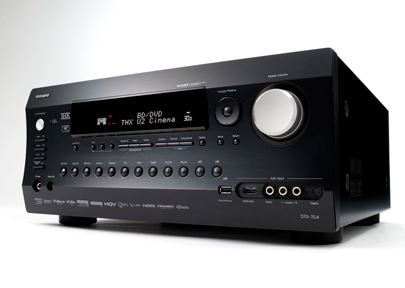
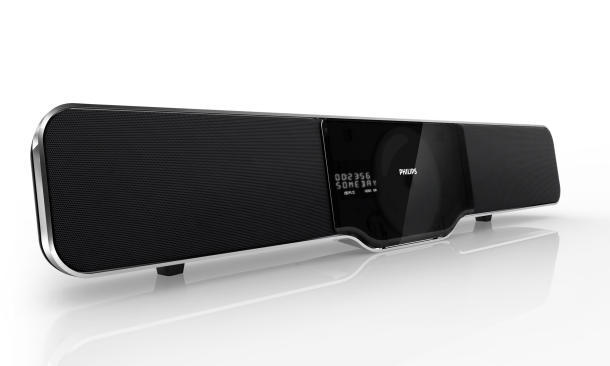
Thus, we have a lot of smart devices at home that can, without the participation of a computer, play music themselves. It makes no sense to keep the computer on for background music. The whole question is how to bring this music to the device?
Many of these gadgets support playback from USB, so many simply write to the USB flash drive and stick it into the right device. But after all, in order to update the repertoire, you will have to pull out the flash drive again, write again, and its volume is limited. And if you want to listen in the next room, again you will not get enough flash drives. And why, if we have a NAS or, even better, a server?
So let's go in order. You can of course just dump all the tracks you like into one folder and listen from it. But it's still more pleasant when there is order. Thus, first of all, it will not be superfluous to organize your library, i.e. lay out on the shelves.
In my opinion now there are 2 standard de facto formats: for lossy it is MP3 , for lossless it is FLAC . They are understood by many devices, even relatively stupid ones. As far as I know, AAC is gaining popularity now, but whether your devices will support it is far from a fact.
I do not advise using WMA because of its proprietary nature. Formats like OGG or APE are easier to forget and transcode to one of the above. Seriously, they are not worth the torment that you have to overcome in order to play, for example, on DLNA.
Also I recommend to refuse from FLAC + CUE . Normal support for this combination is able one and a half player on the PC. On other devices, everything will be 100% worse. If you don’t have a really good reason to still store music in this format, cut it, for example, with the CUE Splitter (Win) in FLAC tracks and forget it.
In addition to well-known encoders like lame, flac or multifunctional ffmpeg, for Windows I can also recommend dBpoweramp Music Converter . It can not only convert, but also perform additional actions on files, such as renaming, tagging, ReplayGain, etc., alas, not for free.
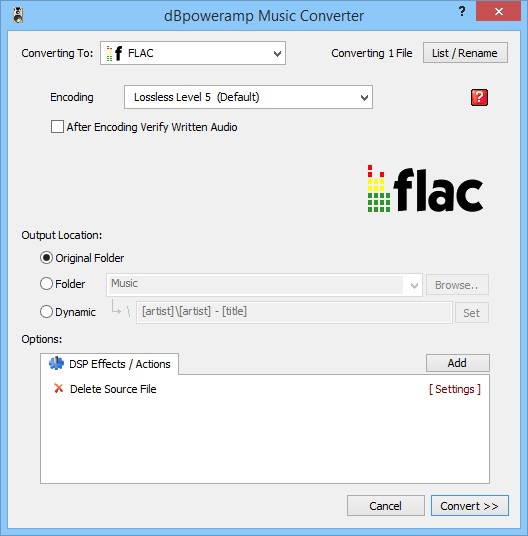
In order for any library organization program to understand what you are shoving, as well as for the players to show you all kinds of nishtyaks like photos of artists, biographies, lyrics and other things, it is necessary that all music be correctly spelled out.
The minimum set of tags includes: Artist , Title , Album , Year , Title , Track No , Genre . With the performer and the name of the track, I think everything is clear. Finding the correct album name and year of release is also easy: use Google, Wikipedia, or services like discogs.com or, in the case of Metal, metal-archives.com . If the album consists of several discs, then it is also worthwhile to specify Disc No.
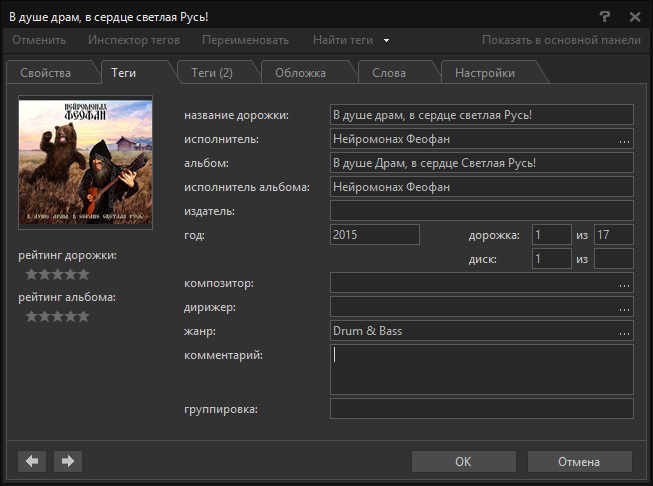
If the album is a collection, you must also register Album Artist . The greatest problem for me is the collections without the clearly expressed central performer. Still not come up with anything smarter. Various Artists.
Writing a cover in tags or not - it seems that things are taste. Personally, I do not register, you can assume that I feel sorry for the place.
The most difficult thing with the genre , as many performers rather vaguely describe their genre, and sometimes just invent a new one. Especially bad with Metal subgenres, because they are just dark. Personally, I take a certain averaged subgenre, if there is something unimaginable, because, alas, idv3 tags do not allow you to specify several genres.
UPD. In fact, you can specify several genres by listing them through the separator ";" or "/". For example, “alternative; rock The question is which of the separators your player understands.
Try to prescribe the original track names using the above services. Useful if accents are used in names.
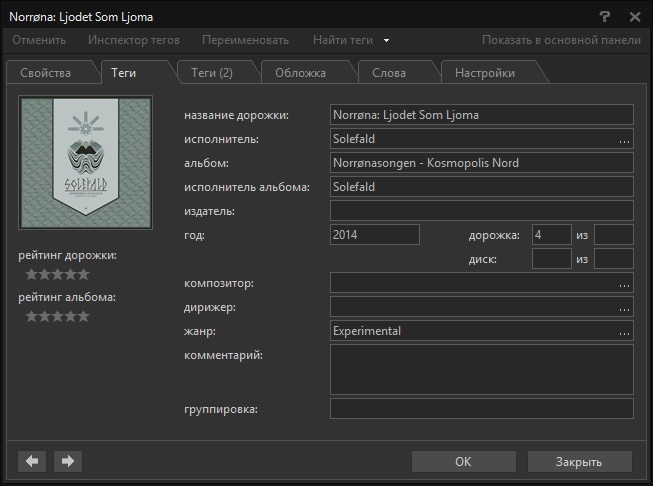
And most importantly: tags must be in unicode. Seriously, if you have not yet unicode, it's time to convert! Save your nerves on the search why do you have cracks instead of Cyrillic.
With the tags decided, then you need to decide how we will store. Personally, I use the following option:
Example
Thus, all the albums of one performer are in one place, and the generalized genre (Rock, Metal, Pop, Electro etc) makes it possible not to arrange a garbage dump from all the best performers in one folder. There are two controversial points: where to put a compilation album or a split album (a joint album of two or more groups), and what to do if the artist dramatically changes the genre. In the latter case, I do not do anything :); I put it in the same folder with other albums. But I do not know how to solve the first problem.
In addition, in the folder with the album will not be superfluous to put the cover. The file should have the name Folder.jpg or Cover.jpg , almost all players, multimedia servers, etc. understand this variant. Size recommend at least 500x500. The easiest way to search for the above services (discogs, metal-archives), or simply in Google Images. Write the cover in the tag or not, as I said, especially your business.
So, if you have Windows, they can help you with the analysis of a media broker and its conversion into a media library:
In addition, various media players often have built-in library organization, but more on that later.
So, we organized the library, now we need to somehow deliver it to home devices. Consider the possible ways to connect.
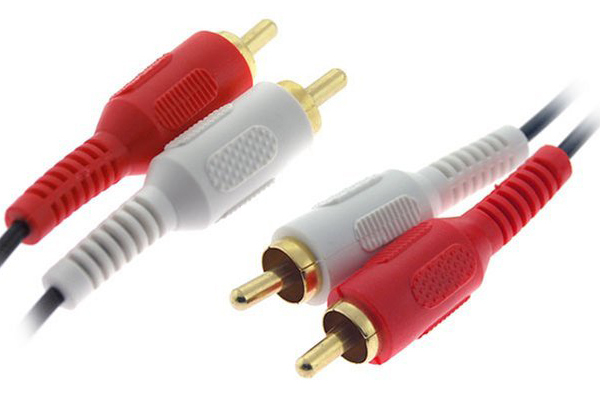
This method of connection is known to all. Fully analog, one cable - one channel. Accordingly, the more channels, the more cables you need.
Pros:
Minuses:
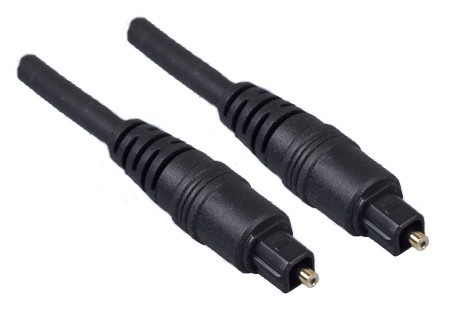
S / PDIF or S / P-DIF - stands for Sony / Philips Digital Interface (or Interconnect) Format. A fairly common way to digitally connect using fiber optic or coaxial cable. There are almost all modern audio input / output devices.
Pros:
Minuses:
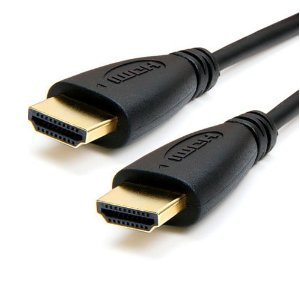
HDMI is now very common. Modern home AV technology connects mainly with this interface.
Pros:
Minuses:
When I first acquired an AV receiver, my first desire was to use it simply as an external sound card, connecting it via HDMI to a computer. However, it was the last minus that did not allow us to take advantage of this solution: the power saving mode of the video card turns off the outputs, thereby putting the monitor into standby mode. The sound, respectively, is also cut down. So either turn off power saving, or don't listen to music.

This mode of transmission is popular primarily in the mobile environment. Some home systems support it, but unfortunately not all.
Pros:
Minuses:

A more sophisticated transfer method developed and promoted by Apple. Requires full infrastructure in the form of a deployed LAN cable and / or Wi-Fi network. Connection to the device via Ethernet or Wi-Fi, depending on the device.
Pros:
Minuses:
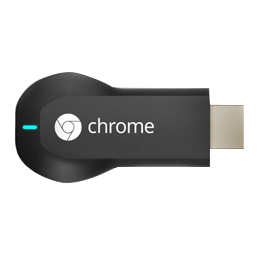
Almost the same as AirPlay, just from Google. Except for Google’s own whistles, the prevalence is even lower.
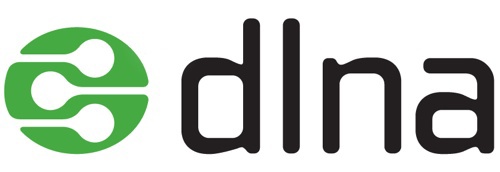
The most sophisticated version at the moment. Typically, such an icon is placed on devices with the prefix Smart, for this is no longer just a stupid column, but a minicomputer that decodes a whole range of formats on its own. The interaction protocol itself is HTTP + XML.
Ideologically, DLNA for stationary devices consists of 3 components:
DMR and DMC can be combined in one device, and can be completely different. For example, you can start a movie on your home NAS from a home tablet and fully control its playback (pause, rewind, volume control).
This is all great, but for some reason, many people miss one very important moment for music: DLNA cannot playlists! The ability to create a playlist may be a specific DMC, and may not be, and most likely will not. My Yamaha AV receiver does not have this option. You can listen to one album without any problems, but several albums are already a problem.
Pros:
Minuses:

In theory, the standard wants to be industrial, but it seems that only British company Linn Devices, which makes network audio players, maintains and develops.
In fact, this is an extension of the DLNA standard, introducing into it the concept of a device playlist. Those. Now the device-render itself is able to playlists, so that it can independently play music without constantly running DMC on the third device. Moreover, it becomes possible to control the device from any number of DMCs that support the OpenHome extension — they will all see the same playlist, current track, etc.
Demonstration of this feature by some Stephen Phillips:
Thus, we have all the pros and cons of DLNA, but with playlists. The main minus one is weak support by third-party software and manufacturers. In addition to the software from Linn, the BubbleUPnP product series and, suddenly, the plugin for foobar2000, almost no one claims its support. However, more on that later.
So, we have a prepared library, we know how to connect. It remains to choose a source. Consider some options.

Seriously? What place is generally convenient to use? With a high probability, the playing device will not be able to playlists. So the maximum use of flash drives is to watch photos and film on TV right now.
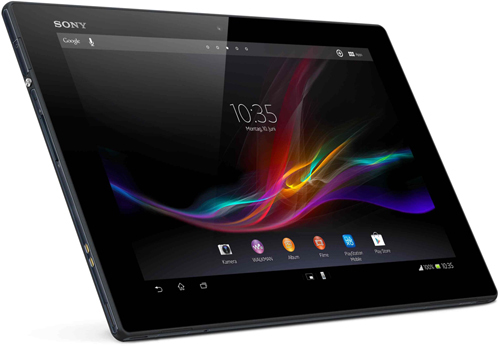
Pros:
Minuses:
I personally am most confused by the small storage and its not high reliability. Yes, and additional distortion due to lossy Bluetooth codecs do not want to have. My receiver has no Bluetooth support at all. However, there is a Bluetooth receiver in the form of an optional accessory.
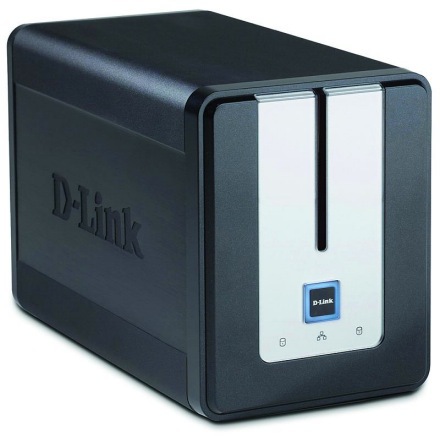
Devices initially with sound unrelated. However, with storage volumes everything is much better.
Pros:
Minuses:
Some people have enough of this, but personally I am for the last option.
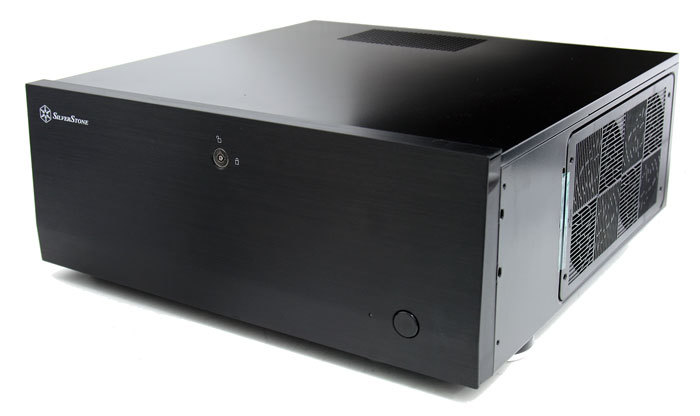
The coolest, but also the most expensive option. You can go both along the path of the NAS, and along the path of the HTPC, the most important thing is that almost all the connection options are available to us, both physical (RCA, SPDIF, HDMI), and over the network (AirPlay, DLNA).
Pros:
Minuses:
I went on the NAS path, having collected a home server with RAID5 of 4 disks. The file system is exported via Samba, and the media library, including using DLNA.
A few words about the choice of DLNA-server. I tried many and made the following for myself:
Based on this, on the basis of my choice fell on the minidlna . Miniature, written in C, the media database in sqlite format, it's not difficult to get into it yourself.
However, due to its minimalism, additional features are supplied only as third-party patches .
At least I recommend No cover resize - according to the standard, the size of the cover is limited to 160x160, which on modern FHD and Retina devices looks, let's say, soapy. With this patch, minidlna will give away the cover as it is, albeit breaking the standard.
Also, if you need minidlna on Windows, there is a patch for building under cygwin with instructions. To start as a service, take WinRun4J .
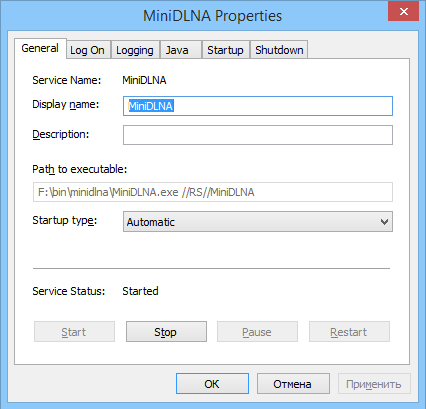
Well, if you wanted to get hold of OpenHome support from Linn, then BubbleUPnP Server should be added to minidlna’s companions. This is a small free Java application that implements some additional functionality for the Android application BubbleUPnP. Of the nice buns actually the ability to make from the usual DMR compatible with OpenHome, with the support of playlists, etc.

For some reason, everyone misses the point of controlling playback, as if this is the simplest task that does not require attention. Not at all, for me personally, this is one of the most difficult moments, if only because of the previously voiced problem of playlists.
Personally, I still like Winamp. But let's face it, he stopped development 10 years ago.In addition to free-form skins, there are still no major innovations. The playlist is simply inconvenient, there is not even a banal grouping by albums / performers. I am silent about the support of such things as DLNA or Chromecast. And it seems no one will add them there. But for AirPlay there is a paid plugin .
Oddly enough, among the developers of the players, no one seriously bother with DLNA support. Usually, the whole thing is limited either by the ability to view and play the DLNA library on the local device, or by exporting the local library using the DLNA protocols. Units can work as a full-fledged DMC, and they, in turn, are usually quite low-functional and not very convenient.
So let's go in order.

The best DLNA controller I've seen under Android. The Google Play lives here . He knows how to play DLNA content locally, to pretend to be the server himself, and to play on remote renderers. Able to playlists, understands OpenHome, can Chromecast. Just a very wonderful software if you want to steer DLNA from an Android device. Unfortunately, not free, but worth it. Separately, I note that in the DMC mode, the Android device itself does not decode anything, the files are played directly by the DMR itself to the best of its capabilities.
If you add BubbleUPnP Server, you can steer your renderers from any Android device with a single playlist, position, etc., like in the video above.
Unfortunately, there is no desktop version for Windows, and since my main working machine is spinning under Windows, I would like to control the music from there, and not reach for the remote or tablet every time I didn’t like the song;).
So let's look at what is for Windows.
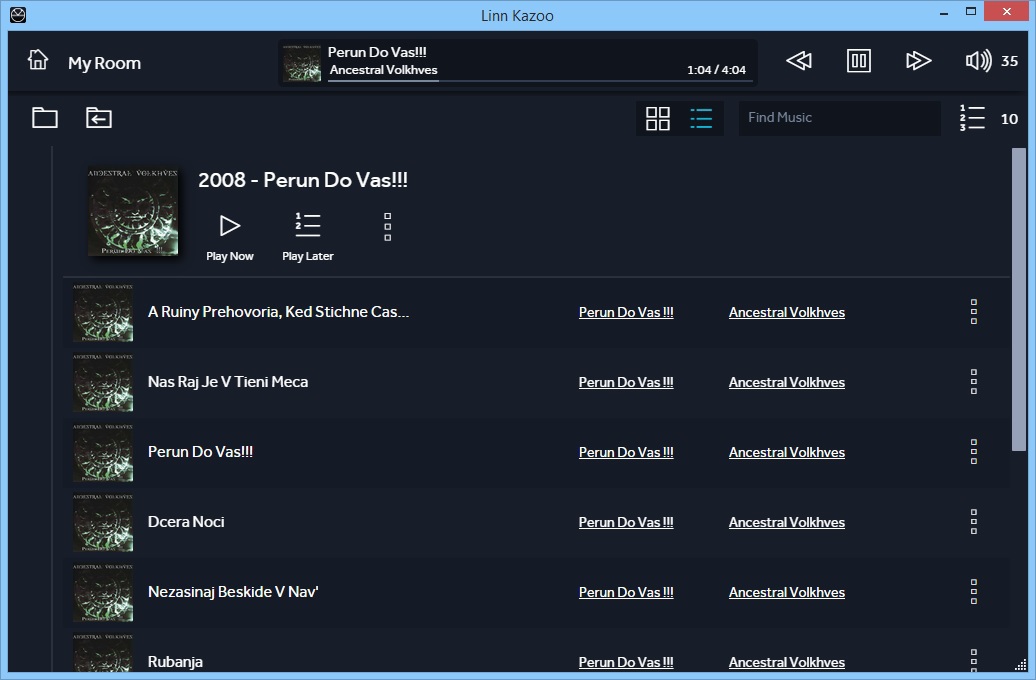
If we are talking about Linn Devices, then why not try their official apps ? Moreover, having installed BubbleUPnP Server, they begin to perceive our devices normally. In general, everything works, the library is viewed, playlists are added, music plays. Moreover, BubbleUPnP on Android again sees the same playlist and current track. But that's all, use is not particularly convenient. Winamp had a wonderful minimalistic mode, when the entire player was rolled up into a strip with a height of a couple of pixels, while the name of the track was visible and there were control buttons. Yes, many Win-players have something similar. But not here.
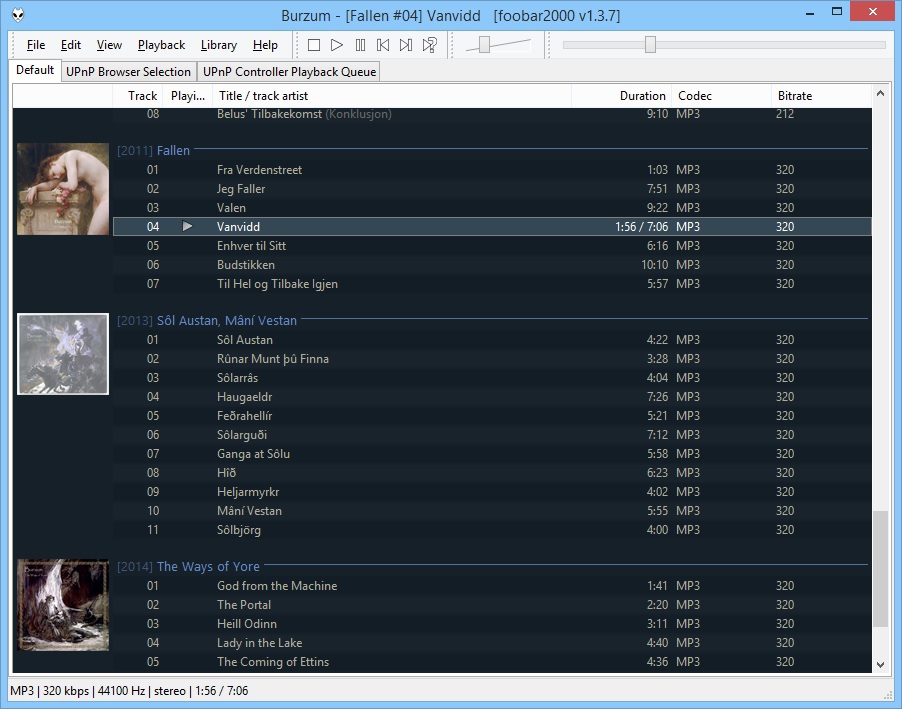
At one time, if not the first, then at least the second most popular player. On the one hand, it is absolutely austere and nothing can play out of the box except to play music, on the other hand, plug-ins can bloat anything. Not bad if you are going to listen to music locally (with built-in sound), or by direct physical connection.
There are many builds that make foobar2000 beautiful, but in actual fact they are just tons of crutches, scripts, etc., which will easily break when you update the supporting plugins. Unfortunately, he doesn't have a compact mode like Winamp. There is a foo_tilte plugin , but the implementation for my taste is lame.
On our topic of remote playback there are the following plugins:
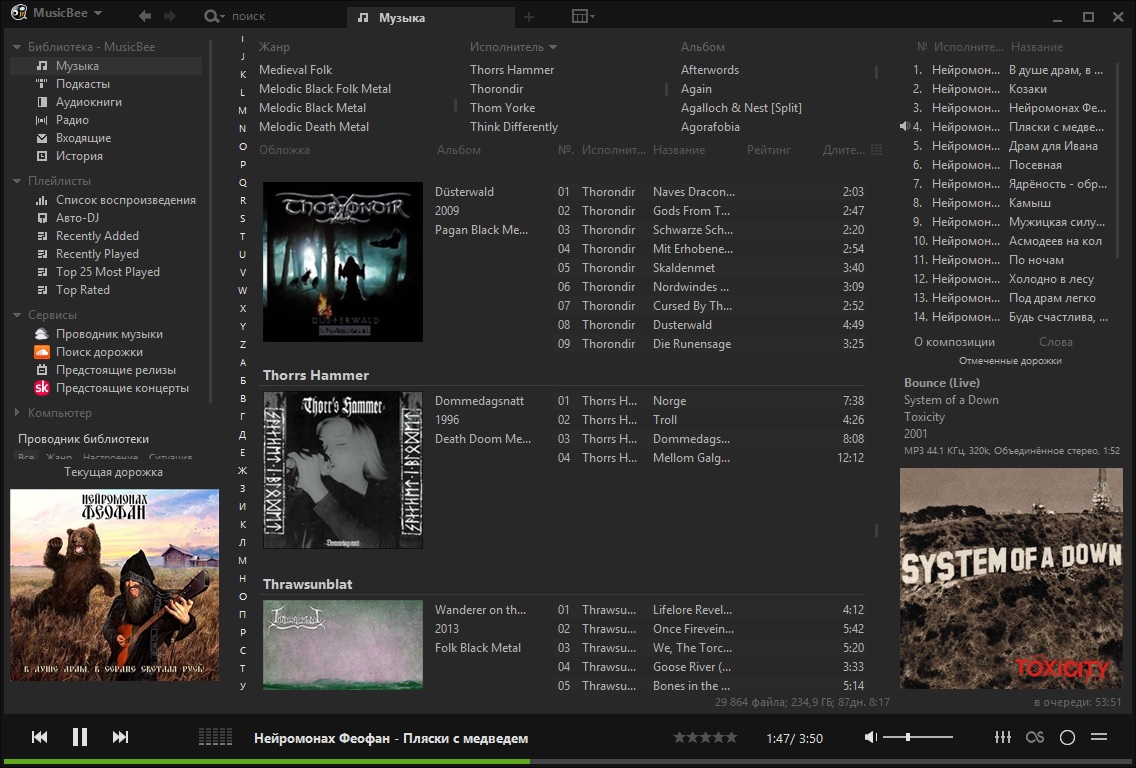
A relatively young player, I had never heard of it before, I stumbled on, one might say casually. Based on the BASS library, written in the .NET Framework. In fact, this is a music organizer paired with a player, like MediaMonkey, but free. Unfortunately, not opensource. Developed by one person under Windows. Work under Mac OS X and Linux is not guaranteed, as the author, according to him, is not interested in this. However, there are informal instructions on how to run. The official site is here .
The player is pleasing to the eye and out of the box, well managed by the library, there are several interesting concepts not found in other players, for example, the “Inbox” folder for newly added tracks. Supports radio, scrobling, tag loading from the network and much more.
A separate plus is that you can change the output device directly from the playback context menu, you do not have to go deep into the settings to switch the output from the headphones to the receiver or the soundbar in the next room. And separately, I’ve a plus for the compact mode:

As for remote playback, there is already out_apx for AirPlay and our own DLNA plugin . Unfortunately, this plugin cannot work as a DMC and does not understand remote DMS libraries. However, he can export his library and knows how to use DMR as remote columns. Unlike the similar plugin for foobar2000 (foo_out_upnp), it really works.
The name of the track on the device is also transmitted. From the device itself, you can click back-forward tracks, rewind works. As I believe, the player itself still decodes for playback, but the signal on the DMR is sent to the PCM, but I can’t say for sure. Remote library can be steered and Samba / NFS.
By itself, WMP can both play a remote DLNA library, and work as a controller with its local (PlayTo function). Unfortunately, with the support of formats it is somewhat sad, there are few tools for working with playlists, and even fewer third-party plug-ins.
The Tiled Music app doesn’t hear anything about DLNA and AirPlay, so only local playback.
As I noted in the introduction, the woman had no problems, the woman bought a pig. Unfortunately, almost all solutions have their technical limitations and are sometimes extremely inconvenient to use.
The most hassle-free is still a direct physical connection to the playback device. For modern digital AV receivers and soundbars, this is SPDIF or HDMI, and HDMI is preferable, because the channel width allows you to transmit many more channels without compression. After all, the less the compression of the already compressed formats, the less the loss in quality.
Unfortunately, direct physical connection can often connect only one device in close proximity to the sound source. Of course, in the case of HDMI there are switches, but, alas, they are not penny. Yes, HDMI cables, unlike Ethernet, in my experience are much more fragile, and the longer its length, the more likely the breakdown.
Bluetooth paranoids from the sound will not work, because it uses lossy compression to transmit sound and nothing can be done about it. There is an extension of aptX , which is now being forced to CSR, but it is supported by one and a half devices on special licensed chips of a particular company.
If you're a fan of Apple, then maybe it's worth the trouble with AirPlay players. Somewhat confusing is the contradictory information that only stereo is supported. Those.Multichannel discs on the home theater will not listen. However, I personally did not check.
Finally, almost all Smart devices support DLNA. A piece introduces a lot of new entities, i.e. it is no longer just a network speaker or network display, moreover, each manufacturer wraps it with its crutches. So 100% support for this technology does not hope. However, in return, you get a truly unified media space for all your smart devices. Is that I would like more complete support in the players.
That's all I can tell you at the moment. If you have your own success stories or interesting tools to support your libraries - share in the comments to the article.
Many times I saw videos with HTPC and beautifully organized video libraries, with movie covers, annotations for TV shows, etc., but unfortunately I still don’t know how to do it right. Maybe someone who owns knowledge will write such an article?
Actually, the music was listened to with built-in zvukovuhi on ordinary computer tweeters without any complaints. But a few years ago, suddenly I wanted something more. What is called, the woman had no problems, the woman bought a pig. In this article I will try to share with you personal experience in organizing home sound.
Problem
I do not deny that there are probably many who still listen to music directly from the computer using active speakers. However, the technical revolution does not stand still, at home there are more and more smart devices. This TVs with SmartTV function and various soundbars to them, which, however, can play you music without TV. In my case, besides the TV, an AV receiver 5.1 appeared with the ability to connect to the LAN. In addition, many, including myself, have started a home server, if not a home server, then at least a NAS or something similar.
')


Thus, we have a lot of smart devices at home that can, without the participation of a computer, play music themselves. It makes no sense to keep the computer on for background music. The whole question is how to bring this music to the device?
Many of these gadgets support playback from USB, so many simply write to the USB flash drive and stick it into the right device. But after all, in order to update the repertoire, you will have to pull out the flash drive again, write again, and its volume is limited. And if you want to listen in the next room, again you will not get enough flash drives. And why, if we have a NAS or, even better, a server?
Library organization
So let's go in order. You can of course just dump all the tracks you like into one folder and listen from it. But it's still more pleasant when there is order. Thus, first of all, it will not be superfluous to organize your library, i.e. lay out on the shelves.
Formats
In my opinion now there are 2 standard de facto formats: for lossy it is MP3 , for lossless it is FLAC . They are understood by many devices, even relatively stupid ones. As far as I know, AAC is gaining popularity now, but whether your devices will support it is far from a fact.
I do not advise using WMA because of its proprietary nature. Formats like OGG or APE are easier to forget and transcode to one of the above. Seriously, they are not worth the torment that you have to overcome in order to play, for example, on DLNA.
Also I recommend to refuse from FLAC + CUE . Normal support for this combination is able one and a half player on the PC. On other devices, everything will be 100% worse. If you don’t have a really good reason to still store music in this format, cut it, for example, with the CUE Splitter (Win) in FLAC tracks and forget it.
In addition to well-known encoders like lame, flac or multifunctional ffmpeg, for Windows I can also recommend dBpoweramp Music Converter . It can not only convert, but also perform additional actions on files, such as renaming, tagging, ReplayGain, etc., alas, not for free.

Tags
In order for any library organization program to understand what you are shoving, as well as for the players to show you all kinds of nishtyaks like photos of artists, biographies, lyrics and other things, it is necessary that all music be correctly spelled out.
The minimum set of tags includes: Artist , Title , Album , Year , Title , Track No , Genre . With the performer and the name of the track, I think everything is clear. Finding the correct album name and year of release is also easy: use Google, Wikipedia, or services like discogs.com or, in the case of Metal, metal-archives.com . If the album consists of several discs, then it is also worthwhile to specify Disc No.

If the album is a collection, you must also register Album Artist . The greatest problem for me is the collections without the clearly expressed central performer. Still not come up with anything smarter. Various Artists.
Writing a cover in tags or not - it seems that things are taste. Personally, I do not register, you can assume that I feel sorry for the place.
The most difficult thing with the genre , as many performers rather vaguely describe their genre, and sometimes just invent a new one. Especially bad with Metal subgenres, because they are just dark. Personally, I take a certain averaged subgenre, if there is something unimaginable, because, alas, idv3 tags do not allow you to specify several genres.
UPD. In fact, you can specify several genres by listing them through the separator ";" or "/". For example, “alternative; rock The question is which of the separators your player understands.
Try to prescribe the original track names using the above services. Useful if accents are used in names.

And most importantly: tags must be in unicode. Seriously, if you have not yet unicode, it's time to convert! Save your nerves on the search why do you have cracks instead of Cyrillic.
File location
With the tags decided, then you need to decide how we will store. Personally, I use the following option:
<Generic Genre> / <Artist> / <Year> - <Album> [/ Disc <Disc Number>] / <Track Number>. <Track name>
Example
Metal / Litvintroll / 2013 - Czornaja Panna / 02. Kryzak (Piesnia Pra Trolau II) .mp3
Thus, all the albums of one performer are in one place, and the generalized genre (Rock, Metal, Pop, Electro etc) makes it possible not to arrange a garbage dump from all the best performers in one folder. There are two controversial points: where to put a compilation album or a split album (a joint album of two or more groups), and what to do if the artist dramatically changes the genre. In the latter case, I do not do anything :); I put it in the same folder with other albums. But I do not know how to solve the first problem.
In addition, in the folder with the album will not be superfluous to put the cover. The file should have the name Folder.jpg or Cover.jpg , almost all players, multimedia servers, etc. understand this variant. Size recommend at least 500x500. The easiest way to search for the above services (discogs, metal-archives), or simply in Google Images. Write the cover in the tag or not, as I said, especially your business.
So, if you have Windows, they can help you with the analysis of a media broker and its conversion into a media library:
- CUE Splitter (freeware) - help cut FLAC / APE + CUE into separate tracks
- FFMpeg (opensource) - a universal converter of everything into everything, but only CLI
- dBpoweramp Music Converter (shareware) - a universal converter of everything (music) to everything with additional buns
- mp3tag (freeware) - universal tag editor, supports many formats
- Tag & Rename (shareware) - as the name says, allows you to edit tags, rename files by template, extort the missing tag fields, album artwork, etc.
In addition, various media players often have built-in library organization, but more on that later.
Connection
So, we organized the library, now we need to somehow deliver it to home devices. Consider the possible ways to connect.
Analog RCA cable, less Jack

This method of connection is known to all. Fully analog, one cable - one channel. Accordingly, the more channels, the more cables you need.
Pros:
- Very common
- Just connect
Minuses:
- Fully analog: the sound quality depends entirely on the sound source. Why cool AV-receiver and speakers, if the sound comes from a netbook with a built-in penny zvukovuha?
- Configurations like 5.1 and above are overgrown with a large number of wires.
S / PDIF

S / PDIF or S / P-DIF - stands for Sony / Philips Digital Interface (or Interconnect) Format. A fairly common way to digitally connect using fiber optic or coaxial cable. There are almost all modern audio input / output devices.
Pros:
- Very common
- Just one cable
Minuses:
- Uncompressed stereo maximum sound
- Transmission of multichannel audio requires precompression into proprietary lossy Dolby Surround or DTS formats. Due to licensing restrictions do not expect that your zvukovuha in a home PC can do it.
HDMI

HDMI is now very common. Modern home AV technology connects mainly with this interface.
Pros:
- Very common
- Just one cable. So, if there is an ARC (Audio Return Channel) at the TV, the same cable is used to transmit sound from the TV to the soundbar or receiver, and to send the picture in the opposite direction if the signal comes from them.
- Allows you to transfer almost any number of audio channels (mono, 2.0, 2.1, 5.1, 7.1, etc.) without compression
Minuses:
- It has limitations on the length of the cable; it can be problematic to reach another room.
- Sound is transmitted only if there is a video signal.
When I first acquired an AV receiver, my first desire was to use it simply as an external sound card, connecting it via HDMI to a computer. However, it was the last minus that did not allow us to take advantage of this solution: the power saving mode of the video card turns off the outputs, thereby putting the monitor into standby mode. The sound, respectively, is also cut down. So either turn off power saving, or don't listen to music.
Bluetooth

This mode of transmission is popular primarily in the mobile environment. Some home systems support it, but unfortunately not all.
Pros:
- Distributed among mobile devices
- Allows you to manage the playback process
Minuses:
- The width of the channels is small, so all sound passes the preliminary lossy encoding
- For the same reason, only stereo
- Among the home (non-mobile) electronics is not so common
Airplay

A more sophisticated transfer method developed and promoted by Apple. Requires full infrastructure in the form of a deployed LAN cable and / or Wi-Fi network. Connection to the device via Ethernet or Wi-Fi, depending on the device.
Pros:
- Supported out of the box by Apple devices
Minuses:
- Requires home network infrastructure
- As far as I know, only stereo sound
- Not very common among non-Apple devices.
Chromecast

Almost the same as AirPlay, just from Google. Except for Google’s own whistles, the prevalence is even lower.
DLNA (UPnP)

The most sophisticated version at the moment. Typically, such an icon is placed on devices with the prefix Smart, for this is no longer just a stupid column, but a minicomputer that decodes a whole range of formats on its own. The interaction protocol itself is HTTP + XML.
Ideologically, DLNA for stationary devices consists of 3 components:
- Digital Media Renderer (DMR) - actually producing device: speaker, TV, receiver
- Digital Media Controller (DMC) - playback control device
- Digital Media Server (DMS) - distribution server
DMR and DMC can be combined in one device, and can be completely different. For example, you can start a movie on your home NAS from a home tablet and fully control its playback (pause, rewind, volume control).
This is all great, but for some reason, many people miss one very important moment for music: DLNA cannot playlists! The ability to create a playlist may be a specific DMC, and may not be, and most likely will not. My Yamaha AV receiver does not have this option. You can listen to one album without any problems, but several albums are already a problem.
Pros:
- If the device supports the format, you can transfer the sound as is, without any processing on the server / controller side
- The transfer protocol allows you to transfer track metadata, including the cover.
- The ability to control playback by a third device (for example, a tablet) is laid out of the box
Minuses:
- Requires home network infrastructure
- It seems that manufacturers have not really agreed on the standards, so the implementation of DLNA from each specific manufacturer, up to each specific product series, drags a whole series of incompatible crutches.
- Playlists are hard
OpenHome ohMedia

In theory, the standard wants to be industrial, but it seems that only British company Linn Devices, which makes network audio players, maintains and develops.
In fact, this is an extension of the DLNA standard, introducing into it the concept of a device playlist. Those. Now the device-render itself is able to playlists, so that it can independently play music without constantly running DMC on the third device. Moreover, it becomes possible to control the device from any number of DMCs that support the OpenHome extension — they will all see the same playlist, current track, etc.
Demonstration of this feature by some Stephen Phillips:
Thus, we have all the pros and cons of DLNA, but with playlists. The main minus one is weak support by third-party software and manufacturers. In addition to the software from Linn, the BubbleUPnP product series and, suddenly, the plugin for foobar2000, almost no one claims its support. However, more on that later.
A source
So, we have a prepared library, we know how to connect. It remains to choose a source. Consider some options.
USB flash drive

Seriously? What place is generally convenient to use? With a high probability, the playing device will not be able to playlists. So the maximum use of flash drives is to watch photos and film on TV right now.
Mobile device

Pros:
- There are more or less advanced players, with support for various formats, playlists, scrolling, etc.
- The small size of the device allows you to carry it around the house.
Minuses:
- Low storage volumes, you can't put a large library in there
- From the available connections we have Bluetooth (lossy), AirPlay / Chromecast or DLNA
- Autonomy limited
I personally am most confused by the small storage and its not high reliability. Yes, and additional distortion due to lossy Bluetooth codecs do not want to have. My receiver has no Bluetooth support at all. However, there is a Bluetooth receiver in the form of an optional accessory.
Home router / NAS

Devices initially with sound unrelated. However, with storage volumes everything is much better.
Pros:
- Hard disks act as storage, and therefore there are no problems with volumes.
- Relatively small size, takes up little space.
- Distributing content via Samba, NFS or even DLNA
Minuses:
- Low power, if that, forget about the transcode right away
- Cut down a specific platform, you can not just take and roll your third-party software
- The devices themselves have no audio / video outputs.
Some people have enough of this, but personally I am for the last option.
Home Server / HTPC

The coolest, but also the most expensive option. You can go both along the path of the NAS, and along the path of the HTPC, the most important thing is that almost all the connection options are available to us, both physical (RCA, SPDIF, HDMI), and over the network (AirPlay, DLNA).
Pros:
- Characteristics are limited only by your imagination.
- Any connection option is available, both directly and via the network.
- Any software, any management methods
Minuses:
- High price
- Few solutions out of the box, you still have to finish your hands
I went on the NAS path, having collected a home server with RAID5 of 4 disks. The file system is exported via Samba, and the media library, including using DLNA.
A few words about the choice of DLNA-server. I tried many and made the following for myself:
- The more features are declared, the less reliably it all works.
- Transcode almost guaranteed to kill rewind. In addition, it loads up the processor. Transcode music is still no problem, the video is unlikely to pull more than 1-2 clients, even on a powerful processor. It is better to keep the files initially in the formats supported by your technique.
- Not all servers work normally with split DMC, it comes to ridiculous, pokes one file, plays another
Based on this, on the basis of my choice fell on the minidlna . Miniature, written in C, the media database in sqlite format, it's not difficult to get into it yourself.
However, due to its minimalism, additional features are supplied only as third-party patches .
At least I recommend No cover resize - according to the standard, the size of the cover is limited to 160x160, which on modern FHD and Retina devices looks, let's say, soapy. With this patch, minidlna will give away the cover as it is, albeit breaking the standard.
Also, if you need minidlna on Windows, there is a patch for building under cygwin with instructions. To start as a service, take WinRun4J .

Well, if you wanted to get hold of OpenHome support from Linn, then BubbleUPnP Server should be added to minidlna’s companions. This is a small free Java application that implements some additional functionality for the Android application BubbleUPnP. Of the nice buns actually the ability to make from the usual DMR compatible with OpenHome, with the support of playlists, etc.

Playback control
For some reason, everyone misses the point of controlling playback, as if this is the simplest task that does not require attention. Not at all, for me personally, this is one of the most difficult moments, if only because of the previously voiced problem of playlists.
Personally, I still like Winamp. But let's face it, he stopped development 10 years ago.In addition to free-form skins, there are still no major innovations. The playlist is simply inconvenient, there is not even a banal grouping by albums / performers. I am silent about the support of such things as DLNA or Chromecast. And it seems no one will add them there. But for AirPlay there is a paid plugin .
Oddly enough, among the developers of the players, no one seriously bother with DLNA support. Usually, the whole thing is limited either by the ability to view and play the DLNA library on the local device, or by exporting the local library using the DLNA protocols. Units can work as a full-fledged DMC, and they, in turn, are usually quite low-functional and not very convenient.
So let's go in order.
Bubbleupnp

The best DLNA controller I've seen under Android. The Google Play lives here . He knows how to play DLNA content locally, to pretend to be the server himself, and to play on remote renderers. Able to playlists, understands OpenHome, can Chromecast. Just a very wonderful software if you want to steer DLNA from an Android device. Unfortunately, not free, but worth it. Separately, I note that in the DMC mode, the Android device itself does not decode anything, the files are played directly by the DMR itself to the best of its capabilities.
If you add BubbleUPnP Server, you can steer your renderers from any Android device with a single playlist, position, etc., like in the video above.
Unfortunately, there is no desktop version for Windows, and since my main working machine is spinning under Windows, I would like to control the music from there, and not reach for the remote or tablet every time I didn’t like the song;).
So let's look at what is for Windows.
Linn Kazoo

If we are talking about Linn Devices, then why not try their official apps ? Moreover, having installed BubbleUPnP Server, they begin to perceive our devices normally. In general, everything works, the library is viewed, playlists are added, music plays. Moreover, BubbleUPnP on Android again sees the same playlist and current track. But that's all, use is not particularly convenient. Winamp had a wonderful minimalistic mode, when the entire player was rolled up into a strip with a height of a couple of pixels, while the name of the track was visible and there were control buttons. Yes, many Win-players have something similar. But not here.
foobar2000

At one time, if not the first, then at least the second most popular player. On the one hand, it is absolutely austere and nothing can play out of the box except to play music, on the other hand, plug-ins can bloat anything. Not bad if you are going to listen to music locally (with built-in sound), or by direct physical connection.
There are many builds that make foobar2000 beautiful, but in actual fact they are just tons of crutches, scripts, etc., which will easily break when you update the supporting plugins. Unfortunately, he doesn't have a compact mode like Winamp. There is a foo_tilte plugin , but the implementation for my taste is lame.
On our topic of remote playback there are the following plugins:
- foo_upnp — , , DMC DMS, DMS DMR. OpenHome. : ( foo_title ), . , .
- foo_out_upnp — , DMR, . .
- out_apx — AirPlay, .
MusicBee

A relatively young player, I had never heard of it before, I stumbled on, one might say casually. Based on the BASS library, written in the .NET Framework. In fact, this is a music organizer paired with a player, like MediaMonkey, but free. Unfortunately, not opensource. Developed by one person under Windows. Work under Mac OS X and Linux is not guaranteed, as the author, according to him, is not interested in this. However, there are informal instructions on how to run. The official site is here .
The player is pleasing to the eye and out of the box, well managed by the library, there are several interesting concepts not found in other players, for example, the “Inbox” folder for newly added tracks. Supports radio, scrobling, tag loading from the network and much more.
A separate plus is that you can change the output device directly from the playback context menu, you do not have to go deep into the settings to switch the output from the headphones to the receiver or the soundbar in the next room. And separately, I’ve a plus for the compact mode:

As for remote playback, there is already out_apx for AirPlay and our own DLNA plugin . Unfortunately, this plugin cannot work as a DMC and does not understand remote DMS libraries. However, he can export his library and knows how to use DMR as remote columns. Unlike the similar plugin for foobar2000 (foo_out_upnp), it really works.
The name of the track on the device is also transmitted. From the device itself, you can click back-forward tracks, rewind works. As I believe, the player itself still decodes for playback, but the signal on the DMR is sent to the PCM, but I can’t say for sure. Remote library can be steered and Samba / NFS.
Windows media player
By itself, WMP can both play a remote DLNA library, and work as a controller with its local (PlayTo function). Unfortunately, with the support of formats it is somewhat sad, there are few tools for working with playlists, and even fewer third-party plug-ins.
The Tiled Music app doesn’t hear anything about DLNA and AirPlay, so only local playback.
findings
As I noted in the introduction, the woman had no problems, the woman bought a pig. Unfortunately, almost all solutions have their technical limitations and are sometimes extremely inconvenient to use.
The most hassle-free is still a direct physical connection to the playback device. For modern digital AV receivers and soundbars, this is SPDIF or HDMI, and HDMI is preferable, because the channel width allows you to transmit many more channels without compression. After all, the less the compression of the already compressed formats, the less the loss in quality.
Unfortunately, direct physical connection can often connect only one device in close proximity to the sound source. Of course, in the case of HDMI there are switches, but, alas, they are not penny. Yes, HDMI cables, unlike Ethernet, in my experience are much more fragile, and the longer its length, the more likely the breakdown.
Bluetooth paranoids from the sound will not work, because it uses lossy compression to transmit sound and nothing can be done about it. There is an extension of aptX , which is now being forced to CSR, but it is supported by one and a half devices on special licensed chips of a particular company.
If you're a fan of Apple, then maybe it's worth the trouble with AirPlay players. Somewhat confusing is the contradictory information that only stereo is supported. Those.Multichannel discs on the home theater will not listen. However, I personally did not check.
Finally, almost all Smart devices support DLNA. A piece introduces a lot of new entities, i.e. it is no longer just a network speaker or network display, moreover, each manufacturer wraps it with its crutches. So 100% support for this technology does not hope. However, in return, you get a truly unified media space for all your smart devices. Is that I would like more complete support in the players.
That's all I can tell you at the moment. If you have your own success stories or interesting tools to support your libraries - share in the comments to the article.
Many times I saw videos with HTPC and beautifully organized video libraries, with movie covers, annotations for TV shows, etc., but unfortunately I still don’t know how to do it right. Maybe someone who owns knowledge will write such an article?
Source: https://habr.com/ru/post/367511/
All Articles